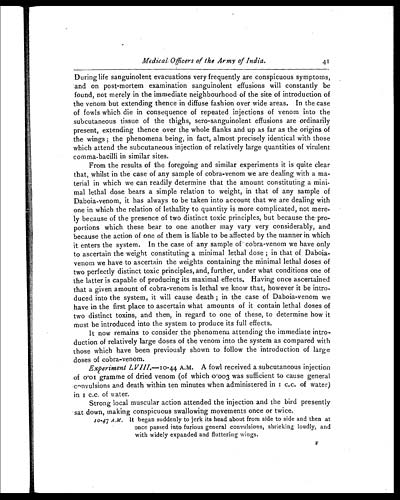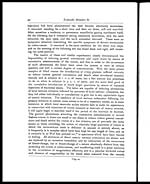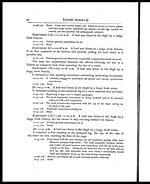Medicine - Institutions > Army health reports and medical documents > Scientific memoirs by medical officers of the Army of India > Part IX, 1895 > 1 - Physiological action of snake-venom
(47) Page 41
Download files
Individual page:
Thumbnail gallery: Grid view | List view

Medical,Officers of the Army of India.
41
During life sanguinolent evacuations very frequently are conspicuous symptoms,
and on post-mortem examination sanguinolent effusions will constantly be
found, not merely in the immediate neighbourhood of the site of introduction of
the venom but extending thence in diffuse fashion over wide areas. In the case
of fowls which die in consequence of repeated injections of venom into the
subcutaneous tissue of the thighs, sero-sanguinolent effusions are ordinarily
present, extending thence over the whole flanks and up as far as the origins of
the wings; the phenomena being, in fact, almost precisely identical with those
which attend the subcutaneous injection of relatively large quantities of virulent
comma-bacilli in similar sites.
From the results of the foregoing and similar experiments it is quite clear
that, whilst in the case of any sample of cobra-venom we are dealing with a ma-
terial in which we can readily determine that the amount constituting a mini-
mal lethal dose bears a simple relation to weight, in that of any sample of
Daboia-venom, it has always to be taken into account that we are dealing with
one in which the relation of lethality to quantity is more complicated, not mere-
ly because of the presence of two distinct toxic principles, but because the pro-
portions which these bear to one another may vary very considerably, and
because the action of one of them is liable to be affected by the manner in which
it enters the system. In the case of any sample of cobra-venom we have only
to ascertain the weight constituting a minimal lethal dose; in that of Daboia-
venom we have to ascertain the weights containing the minimal lethal doses of
two perfectly distinct toxic principles, and, further, under what conditions one of
the latter is capable of producing its maximal effects. Having once ascertained
that a given amount of cobra-venom is lethal we know that, however it be intro-
duced into the system, it will cause death; in the case of Daboia-venom we
have in the first place to ascertain what amounts of it contain lethal doses of
two distinct toxins, and then, in regard to one of these, to determine how it
must be introduced into the system to produce its full effects.
It now remains to consider the phenomena attending the immediate intro-
duction of relatively large doses of the venom into the system as compared with
those which have been previously shown to follow the introduction of large
doses of cobra-venom.
Experiment LVIII. —10-44 A.M. A fowl received a subcutaneous injection
of 0.01 gramme of dried venom (of which 0.003 was sufficient to cause general
convulsions and death within ten minutes when administered in 1 c.c. of water)
in 1 c.c. of water.
Strong local muscular action attended the injection and the bird presently
sat down, making conspicuous swallowing movements once or twice.
10-47 A.M. It began suddenly to jerk its head about from side to side and then at
once passed into furious general convulsions, shrieking loudly, and
with widely expanded and fluttering wings.
F
Set display mode to: Large image | Zoom image | Transcription
Images and transcriptions on this page, including medium image downloads, may be used under the Creative Commons Attribution 4.0 International Licence unless otherwise stated. ![]()
| Permanent URL | https://digital.nls.uk/75002548 |
|---|
| Shelfmark | IP/QB.10 |
|---|---|
| Additional NLS resources: | |




